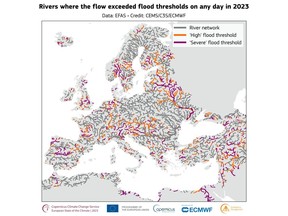Article content
(Bloomberg) — The European Union endured its joint-hottest year on record in 2023, according to new scientific analysis, pointing to a more perilous future for what is already the world’s fastest-warming continent.
Europe experienced its largest wildfire on record last year, as well as one of its costliest-ever floods, according scientists at the Copernicus Climate Change Service and World Meteorological Organization said in their annual roundup of the region’s climate. There’s been no relief from extreme weather across the globe this year, including record-breaking floods that hit Dubai and parts of Russia this week.
Article content
Last year ranked alongside 2020 as Europe’s warmest ever, with record heat driven both by climate change and the El Niño weather pattern, according to the report. The extreme temperatures added fuel to wildfires in the region, burning an area the size of London, Paris and Berlin combined. Greece saw the largest ever wildfire in the EU, scorching 960 square kilometers, or around twice the size of the greater Athens metropolitan area.
Read More: Scientists Are Already Bracing for Record-Breaking Heat in 2024
The global average temperature in 2023 was 1.45C higher than pre-industrial levels, according to WMO data, triggering large amounts of rainfall. Europe as a whole was hit by about 7% more precipitation than usual. In August, Slovenia was battered by floods, creating one of the most expensive natural disasters for an EU country, with billions of euros worth of damage.
Read More: Climate Change Is Raising the Threat Level on Rain
The findings paint a worrying picture for the continent, as carbon-dioxide and methane emissions in the atmosphere are continuing to rise and the rate of warming is around 0.4C per decade in Europe, twice the global average, according to Samantha Burgess, deputy director of the Copernicus Climate Change Service and one of the authors of the European State of Climate report.
Article content
“While we have record air temperatures and record greenhouse gas concentrations in the atmosphere, we are going to continue to see extreme events,” which will become more frequent and intense, she said. “So we are likely to continue to see records until we stabilize our climate and get to net zero.”
Europe will likely have to adapt to higher temperatures quicker than any other region — with areas closest to the Arctic, like Greenland, heating up the fastest. The continent overall is set to face warming of 3C, even if the world is successful in limiting a global rise by that much.
The impacts will be seen most dramatically in areas such as the Alps, where glaciers have lost 10% of their remaining volume over the last two years.
Read More: The Golden Era of European Mountaineering Is Coming to an End
While human-made greenhouse gases are the major contributor to rising global temperatures, Europe’s exceptional increase is also partially explained by its warmer ocean and atmospheric currents. Meanwhile, regulations designed to clean the air have also removed heat reflecting particulates from the atmosphere over the continent.
Article content
The Copernicus program uses billions of measurements from satellites, ships, aircraft and weather stations around the world for its monthly and seasonal forecasts. Along with the European Space Agency, Copernicus plays a central role in the EU’s €16 billion effort to get ahead of climate change through accurate forecasting. This is the first time it’s teamed up with the WMO for this report.
There may be some light relief for Europe in 2024 as El Niño transitions to a more neutral state or even a cooler La Niña event, though scientists said it’s too early to say. The more extreme weather also helped boost Europe’s potential renewable energy production thanks to high winds during the latter part of the year and stronger river flows for hydro. A record amount of clean energy was produced last year, with almost half coming from renewables.
Still, the new scientific findings will add to calls for stronger efforts to cut emissions at home and abroad.
The EU is currently off-track to meet its goal of cutting CO2 emissions by 55% by the end of the decade and polls show that support for parties more skeptical of further climate action is increasing ahead of European Parliament elections in June. A number of policies to make agriculture more environmentally friendly have been scaled back, even as the sector comes under threat from warming temperatures.
Share this article in your social network
